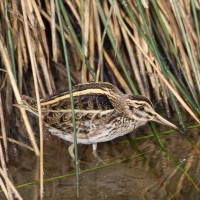Description
The area around Horn kyrka is a quite good site for geese with hundreds of metsähanhi, merihanhi, and kanadanhanhi found most years. Often with lesser amounts of tundrahanhi, tundrametsähanhi, lyhytnokkahanhi, and valkoposkihanhi interspersed. sepelhanhi has been seen. Most geese are found by Rien (marked with a star on the map) in late Febuary and March.
During the spring Riens water overflow and large amounts of open water form. When this happens large amounts of sinisorsa (at most 200), and tavi (at most 150) rest in the area. Among these ducks you can observe smaller amounts of haapana, harmaasorsa, haapana, jouhisorsa (uncommon), Lapasorsa (uncommon), and heinätavi (rare). Sometimes also some diving ducks. But since water levels vary each spring the amount and variation of ducks at Rien vary accordingly. The wetland at Hornebergs holds permanent water, and usually some dabbling ducks, but not in the same amount. Horn Marsh along with its ponds is also quite good for small amounts of different dabbling ducks.
Diving ducks are most usually found in Åsunden with isokoskelo, tukkasotka, telkkä being common, while tukkakoskelo and uivelo are uncommon. At Trossbonäs rare diving ducks like mustalintu, and pilkkasiipi can be found with luck in April. Even haahka and lapasotka have been seen there.
In spring if Rien has water in late April waders rest there. liro, metsäviklo (at most 23), töyhtöhyyppä, and taivaanvuohi (at most 100). On the fields kapustarinta, at Åsunden rantasipi sing, and in the forests lehtokurppa can be found. During heavy autumn rain Rien can gain enough water for waders such as valkoviklo, suokukko, suosirri, kuovi, tylli, and kuovisirri. The fields around Bränna and Västa eneby are pretty good areas for jänkäkurppa in November.
Among predatory birds tuulihaukka, hiirihaukka, Mehiläishaukka, piekana, merikotka, varpushaukka, kanahaukka, sääksi (kalasääski), nuolihaukka and sinisuohaukka are all common. maakotka, ampuhaukka, muuttohaukka, and haarahaukka are all rare but seen some years. The best places for them are Bränna, Rien, and Åshorva.
Large amounts of passerine birds move along the fields around Horn, therefore large amounts of hemppo, niittykirvinen, keltavästäräkki and other common meadows birds are found along with other rare passerine birds like sinirinta, sepelrastas, lapinsirkku (very rare), pulmunen, and vuorihemppo. The best places for these are Bränna and Rien.
The wetland around Rien and Hornsberg have large amounts of reed and trees which make them excellent places for nightactive birds. All the common bird are found some years with ruisrääkkä, viiriäinen, viitakerttunen, viitasirkkalintu, luhtahuitti, and pensassirkkalintu. Even pikkuhuitti has been found.
Details
Access
Horn is located on the southern shores of lake Åsunden. No good parking spots can be found for most of these places but it is often possible to park alongside the road. The area is best explored with bike or car and perhaps not best suited to tourists because there are few facilities for visitors.





